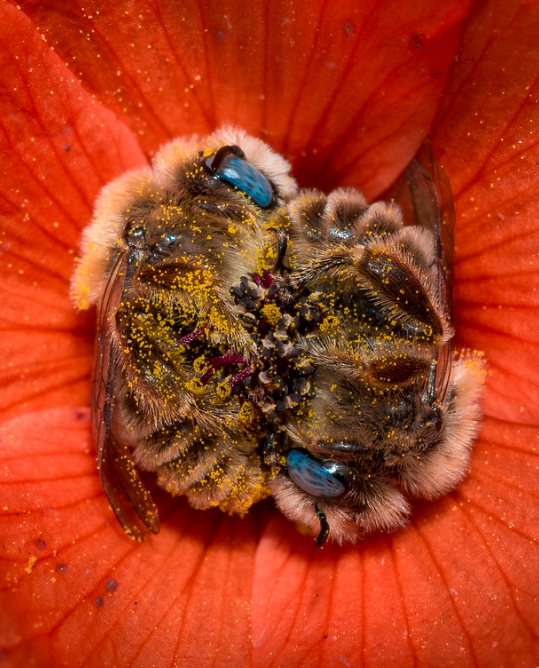Cuddle bee, huddle bee
Curled up in the middle bee
Meet me in your flower chair
Waving on a long stem-stair
Hush the rush of pollen hunting
Curl up in a blossom bunting
Fold your wings and thank the sun
Bee content… your work is done
— by Ruth Gilmore Ingulsrud
≈ Pollen Pillow ≈
This photo of two sleepy bees catching some zzz’s brought me to my knees! Amaz-zzing! Thanks to photographer J M Neely’s skill and patience with the camera, the image of two bees curled up in ying-yang perfection inside an orange Globe Mallow plant was captured and has been making the rounds on social media. These bees do often curl up in their favorite flower to fall asleep. What a lovely place to snooze.
These globe mallow bees, from the hot, dry climates of the Western United States, differ from the more commonly-recognized honey bees.

Photo by J M Neely
Globe mallow bees do not live in hives and do not produce honey like honey bees. They live alone, (solitary like most bees actually), and the females create individual homes or apartments for each baby bee in the ground.
The growing bee larvae is provided nutrition by the mom-bee in the form of a yummy pollen-loaf. She makes this by gathering pollen from the globe mallow flowers that she visits. She packs the pollen grains into long hairs on her hind legs as she flies from flower to flower. She then mixes the pollen grains with nectar and packs it into the small tunnel or bee-baby nursery room under the ground. When the baby bee hatches out, it can start eating its nutritious pollen-loaf.

Bees live very busy lives and need their rest. Most sleep at night, but can also take naps during the day. Bees need sleep just like humans. If they do not get the sleep that they need, it becomes harder for them to do their jobs. When bees sleep, their posture changes. Their wings fold down against their bodies, they curl up in flowers or cling to stems. Their antennae droop down. Even their body temperature drops. If they are in a deep sleep, it takes time and a lot of bright sunlight to wake them.

Photo by GurayDere from Flicker

While solitary female bees have their nests to go to at night to get some sleep, most male bees (of the non-honey-bee variety) have nowhere to sleep. They will find flowers or the stem of a plant to attach to and go to sleep. They will often sleep in groups, with male bees of the same species lined up together.
The photo shown here (on the right) was taken by Dino J. Martins, an entomologist (insect scientist) from Kenyan who loves bugs. He admires a type of bee from east Africa called the “amegilla bee.” It flies fast, works hard and has a high-pitched buzz. At night, the males often find grass or plant stems near swamps or moist places where they stop to sleep for the night. The amegilla bee is only one type of bee among the over 20,000 species that have been identified worldwide. Unfortunately, one out of every four wild bee species is in danger of becoming extinct, or disappearing completely.
While honey bees produce honey and are valuable to humans for this sweet product, all types of bees are important. They all help to pollinate plants which provide us and all living creatures with food.
Boxes of bees are even trucked around the country to farms that grow fruits, nuts and other crops so that the plants will be pollinated by the busy bees. These bees are so valuable that sometimes, the hives are even stolen by bee-rustlers!
A small 8-ounce jar of Manuka money from New Zealand can cost as much as 60 U.S. dollars! So the bees that make honey from the flowering manuka shrub are very valuable as well. Farmers have begun adding cameras to their farms and attaching tracking devices to their bee hives in order to protect themselves from theft. Since bee populations have been decreasing in the past few years because of disease, chemicals and stress on the insects, bees have become even more valuable.
So if you happen upon a sleeping bee, let it be! These valuable little critters need their sleep. They really do need to catch their z’s!
≈≈≈≈≈≈≈≈≈≈≈≈≈≈≈≈≈≈≈≈≈≈≈≈≈≈≈≈≈≈≈≈≈≈≈≈≈≈≈≈≈≈≈≈≈≈≈≈≈≈≈≈≈
Author’s Note:
Subscribe to Beloved of Beasts by adding your email to the box at the upper right section of this page. And send me an email if you would like to request a poem and article about a beloved beast of your own!

